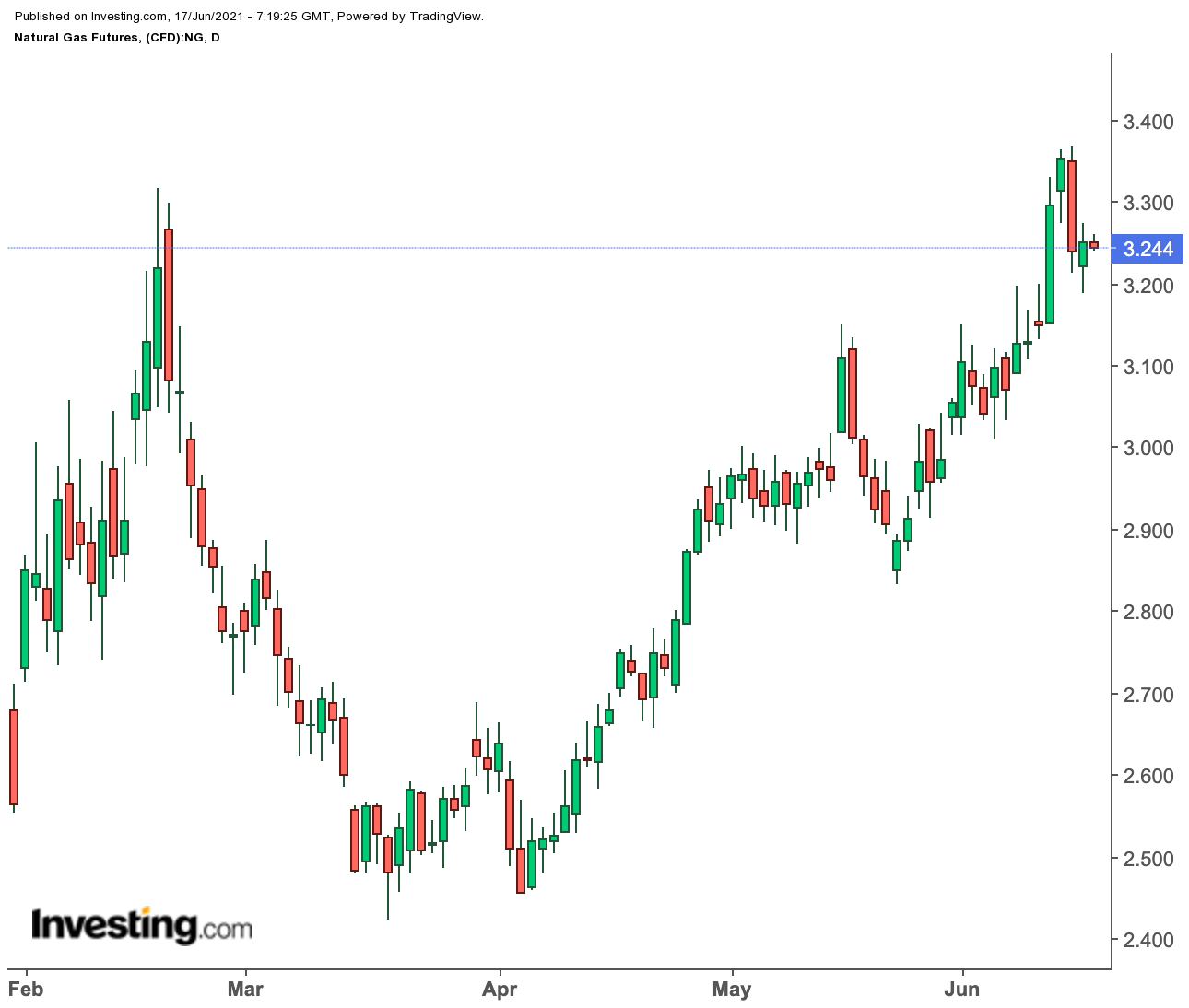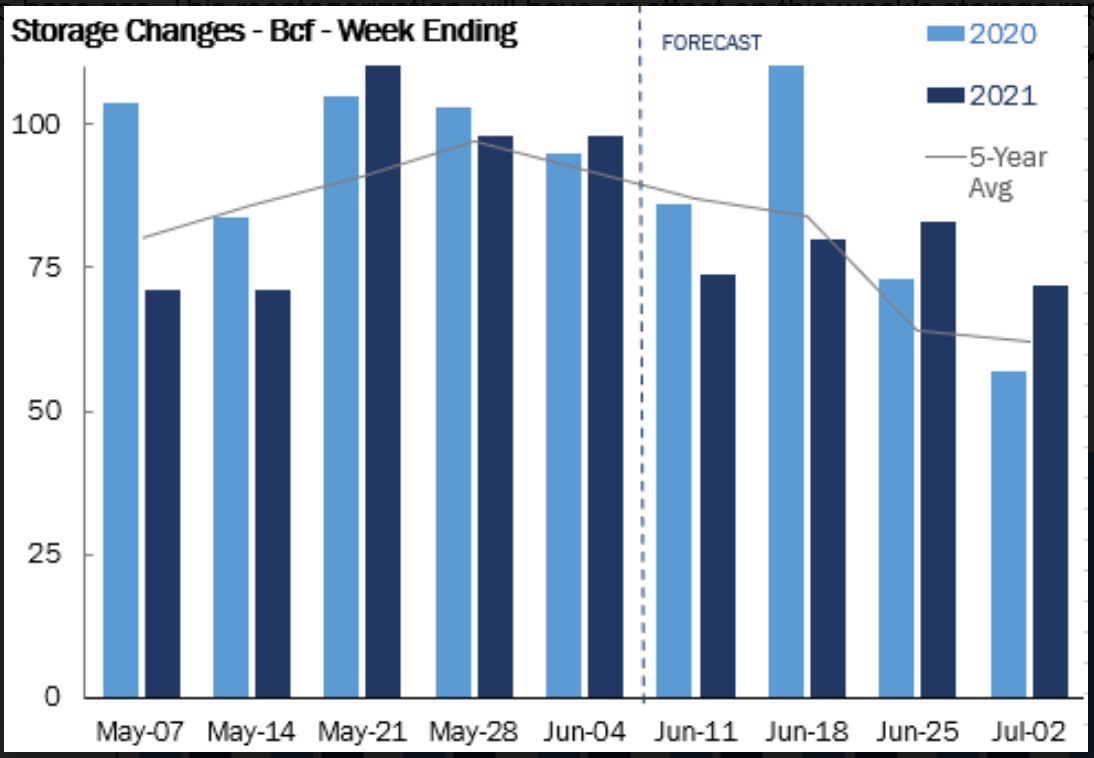The natural gas bull is having one of the best times in years.
While almost every advisory on the trade has the obligatory caution to beware of price swings, there is barely anything of that sort happening.
For a market dubbed the “Wild West” or “Bucking Bronco” of commodities, natural gas is bereft of any volatility now, staying steadily above $3 per mmBtu, or million metric British thermal units, thanks to increasingly warmer weather that could build to a near record high heat soon.

To the gas bull, this means only one thing: enjoy the one-way ride while it lasts.
Near Record Heat Likely
The pattern remains “hotter-biased” even with “some cooler weather into the Midwest and East at times, as western heat, plus hotter temperatures down in Texas, is enough to offset the cooling,” Bespoke Weather said in an outlook carried by industry portal naturalgasintel.com.
The forecaster added:
“We remain on pace to come close to record hot levels for June as a whole. The expectation that the hotter bias of the pattern rolls on into July.”

Source: Gelber & Associates
In Wednesday’s session on the New York Mercantile Exchange’s Henry Hub, front-month gas futures for July settled up 1.1 cents at $3.25 per mmBtu, after a 7-month high at $3.37. Since May 26, July gas has hit daily highs above $3.
In Wednesday’s trade, the balance of the Henry Hub calendar strip for summer through spring next year—or August through March—also settled above $3.
Those settlements came ahead of the Energy Information Administration’s weekly storage report on natural gas, due at 10:30 AM ET (14:30 GMT) today.
A consensus of analysts tracked by Investing.com are forecasting an injection of 72 bcf, or billion cubic feet, into storage for the week ended June 11, versus the 86-bcf build during the same week a year ago and the five-year (2016-2020) average injection of 87 bcf.
In the previous week to June 4, utilities injected 98 bcf into storage.
Houston-based gas consultancy Gelber & Associates said in a note to its clients distributed on Wednesday:
“Increasing production (last week), decreasing export flows, and increased price-responsive fuel switching to coal will threaten to push residuals even higher, preventing storage numbers from dipping too low.”
If analysts’ gas storage estimates for last week are on target, the injection during the week ended June 11 would take stockpiles up to 2.483 tcf, or trillion cubic feet, some 2.7% below the five-year average and 13.8% below the same week a year ago.
According to a temperature reading by data provider Refinitiv, last week’s conditions were warmer than usual, with 77 CDDs, or cooling degree days, versus a 30-year average of 57 CDDs for the period.
CDDs are used to estimate demand to heat homes and businesses, measuring the number of degrees a day's average temperature is below 65 degrees Fahrenheit (18 degrees Celsius).
Back to Bespoke’s weather outlook, it observed little day-to-day change in its latest projections Wednesday, with heat remaining a dominant theme over large swaths of the country. That is expected to translate into elevated demand for natural gas to power air conditioners.
Hurricane Warning
Two weeks into the 2021 Atlantic hurricane season, the National Hurricane Center on Wednesday warned of a 70% chance for a disturbance near southern Mexico to develop into a tropical cyclone later this week. The disturbance also has a 90% chance of becoming at least a tropical depression. The storm, which could be named Claudette, was expected to begin moving northward on Thursday, bringing heavy rains to parts of the northern Gulf Coast on Friday, the Hurricane Center said.
Parts of Louisiana, Mississippi, and Alabama could see several inches of rain later this week. Bespoke said significant production interruptions in the US offshore were unlikely, though the system could usher in cooler winds and ease a heat wave that has gripped parts of the Gulf Coast states and Texas this week.
Feed gas volumes for LNG, or liquefied natural gas, have, meanwhile, been choppy through June amid seasonal maintenance work, naturalgasintel.com said in a blog.
However, following maintenance work, exports of the super-chilled fuel are expected to rise back above 11 bcf per day—where they hovered most of the spring—because of high demand from markets across Europe and Asia.
Additionally, production of gas dipped lower to around 90 bcf, down from recent highs above 92 bcf.
The Electric Reliability Council of Texas, or ERCOT, which operates 90% of the state’s electric grid, asked Texans this week to conserve as much energy as possible until Friday. ERCOT officials cited heat that is more intense than normal for June and forced outages at power plants.
Disclaimer: Barani Krishnan uses a range of views outside his own to bring diversity to his analysis of any market. For neutrality, he sometimes presents contrarian views and market variables. He does not hold a position in the commodities and securities he writes about.
